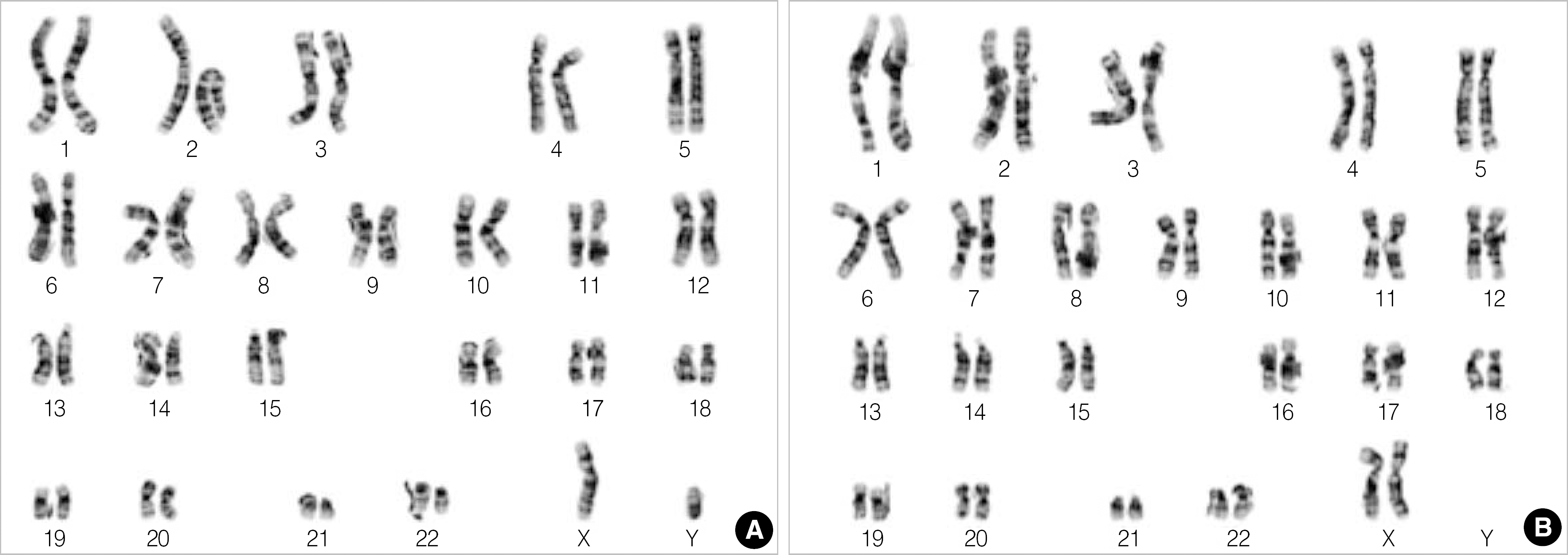Abstract
Blood chimerism in twins is known to occur through the transfer of hematopoietic stem cells between the fetuses via a common placenta. We present a case of blood chimerism in a dizygotic dichorionic twin pregnancy. The female twin was delivered at 34 weeks of gestation, and the male twin was stillborn. Pathologic examination confirmed dichorionic diamniotic placentas. The karyotype of the female child was obtained using peripheral blood sample, and it revealed a mixture of 46,XX and 46,XY cells (chi 46,XY[13]/46,XX[7]). FISH analysis performed on the buccal cells by using CEP X/Y probe (Abbott Molecular Inc., USA) revealed 100% XX signals (nuc ish Xcen(DXZ1×2)[500]). Gross examination of the external genitalia and abdominal ultrasonography revealed no definitive abnormal findings in relation to sex differentiation. When XX/XY chimerism is present in blood lymphocytes, careful examination of external genitalia and reproductive organs and further studies are required to detect chimerism in non-hematopoetic tissues. This is a rare case of blood chimerism in dichorionic placentas, in contrast to those in monochorionic placentas.
Go to : 
REFERENCES
1.Gencík A., Genciková A., Hrubisko M., Mergancová O. Chimerism 46,XX/46,XY in a phenotypic female. Hum Genet. 1980. 55:407–8.

2.Souter VL., Parisi MA., Nyholt DR., Kapur RP., Henders AK., Opheim KE, et al. A case of true hermaphroditism reveals an unusual mechanism of twinning. Hum Genet. 2007. 121:179–85.

3.Schoenle E., Schmid W., Schinzel A., Mahler M., Ritter M., Schenker T, et al. 46,XX/46,XY chimerism in a phenotypically normal man. Hum Genet. 1983. 64:86–9.

4.Williams CA., Wallace MR., Drury KC., Kipersztok S., Edwards RK., Williams RS, et al. Blood lymphocyte chimerism associated with IVF and monochorionic dizygous twinning: case report. Hum Reprod. 2004. 19:2816–21.

5.Souter VL., Kapur RP., Nyholt DR., Skogerboe K., Myerson D., Ton CC, et al. A report of dizygous monochorionic twins. N Engl J Med. 2003. 349:154–8.

6.Sudik R., Jakubiczka S., Nawroth F., Gilberg E., Wieacker PF. Chimerism in a fertile woman with 46,XY karyotype and female phenotype. Hum Reprod. 2001. 16:56–8.
7.van Dijk BA., Boomsma DI., de Man AJ. Blood group chimerism in human multiple births is not rare. Am J Med Genet. 1996. 61:264–8.

8.Chown B., Lewis M., Bowman JM. A pair of newborn human blood chimeric twins. Transfusion. 1963. 3:494–5.

9.Kühl-Burmeister R., Simeoni E., Weber-Matthiesen K., Milde A., Herwartz C., Neppert J, et al. Equal distribution of congenital blood cell chimerism in dizygotic triplets after in-vitro fertilization. Hum Reprod. 2000. 15:1200–4.
10.Ekelund CK., Skibsted L., S⊘gaard K., Main KM., Dziegiel MH., Schwartz M, et al. Dizygotic monochorionic twin pregnancy conceived following intracytoplasmic sperm injection treatment and complicated by twin-twin transfusion syndrome and blood chimerism. Ultrasound Obstet Gynecol. 2008. 32:832–4.

11.Johannsen TH., Lundsteen C., Visfeldt J., Schwartz M., Petersen BL., Byskov AG, et al. Erroneous genetic sex determination of a newborn twin girl due to chimerism caused by foetal blood transfusion. A case report. Horm Res. 2003. 60:148–51.
12.Walker SP., Meagher S., White SM. Confined blood chimerism in monochorionic dizygous (MCDZ) twins. Prenat Diagn. 2007. 27:369–72.

Go to : 




 PDF
PDF ePub
ePub Citation
Citation Print
Print




 XML Download
XML Download